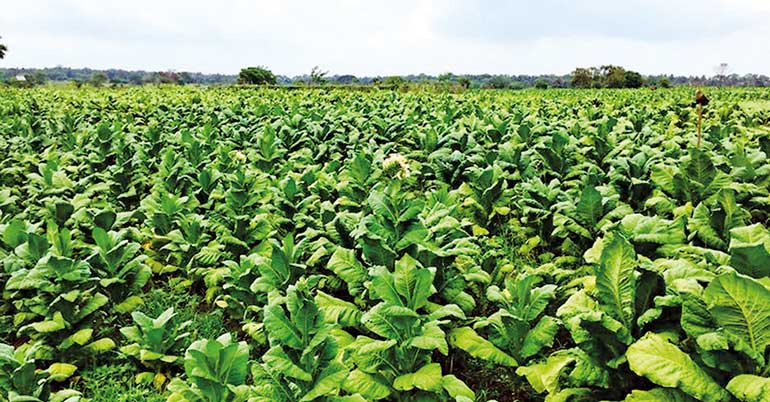Saturday Sep 13, 2025
Saturday Sep 13, 2025
Tuesday, 31 May 2022 01:09 - - {{hitsCtrl.values.hits}}

Tobacco is a serious threat to soil fertility
By Randima Attygalle
Tobacco is the world’s leading cause of preventable death, killing nearly 8 million persons every year. Tobacco is also a major risk factor for leading non-communicable diseases (NCD) including cancers, cardiovascular diseases, chronic lung diseases and diabetes.
According to the WHO findings, tobacco claims 1.6 million lives in the South East Asia Region (SEAR) alone which is also amongst the largest producers and consumers of tobacco products. India and Indonesia are among the top five producers of tobacco in the world.
SEAR accounts for 81% of smokeless tobacco users. It is also home to more than 22% of global adult smokers aged 15 years and above. Over a third of the world’s children aged 13 to15 years (34% or 14.8 million) using various forms of tobacco, belong to the SEAR, WHO points out. Tobacco is closely linked to the poverty and development in the region.
Developing nations at stake
With an annual greenhouse gas contribution of 84 megatons carbon dioxide equivalent, the tobacco industry contributes to climate change and reduces climate resilience, wasting resources and damaging ecosystems. WHO data reveals that around 4.5 trillion cigarettes are discarded to the environment every year. There are over 7,000 chemicals released into the environment from use of a cigarette – 70 of which are known carcinogens. It is now well-established that cigarette filters (butts) are among the topmost polluting and toxic substances found in water bodies. It takes a cigarette butt approximately 10 years to decompose, allowing time for nicotine and chemicals to leach into surrounding ecosystems.
Launching this year’s global campaign for World No Tobacco Day under the banner ‘Tobacco: Threat to our Environment’, WHO’s Director of Health Promotion, Dr. Ruediger Krech in a communiqué remarked that, ‘the environmental impacts of tobacco add unnecessary pressure to our planet’s already scarce resources and fragile ecosystems.’ The health expert also warned that this is especially dangerous for developing countries where most of the tobacco production happens. “Every cigarette you smoke, you are literally burning resources where they are already scarce, burning resources where our very existence depends upon,” he noted.
The communiqué further notes that in low- and middle-income countries, many farmers and government officials see tobacco as a cash crop that can generate economic growth; however, the short-term cash benefits of the crop are offset by the long-term consequences of increased food insecurity, frequent sustained farmers’ debt, illness and poverty among farm workers, and widespread environmental damage in low- and middle-income countries.
A destructive crop
An estimated 1.5 billion hectares of (mainly tropical) forests have been lost worldwide since the 1970s due to tobacco, contributing to up to 20% of annual greenhouse gas increase, points out the WHO. Trees are cut down to clear land for tobacco farming and in addition, wood is burned for the curing of tobacco leaves after harvest. It takes approximately one entire tree, to make 300 cigarettes. Around 200,000 hectares of land is cleared annually for tobacco growing and curing. Tobacco farming accounts for about 5% of the total national deforestation, disproportionately affecting tobacco growing regions of the world, including Southern Africa, the Middle East, Southeast Asia, South America and the Caribbean.
As the SouthEast Asia Tobacco Control Alliance notes, tobacco is destructive to the environment at every single stage of its cycle – cultivation, product manufacture, distribution, consumption, and post-consumption. ‘The tobacco cycle ruins soil quality, perpetuates global deforestation, exposes growers to harmful substances, pollutes the air and generates massive amounts of toxic waste, including hundreds of millions of kilograms of cigarette butts each year as well as materials from electronic smoking devices’, the Alliance notes.
Depleting soil’s nutrient pool
The impact of tobacco cultivation on soil’s fertility is serious as explained by Saman Dharmakeerthi, Professor in Soil Fertility and Nutrient Management, Head of the Department of Soil Science, Faculty of Agriculture, University of Peradeniya and the Chairperson, Board of Study in Soil Science, Postgraduate Institute of Agriculture (PGIA).
“Tobacco is a crop that mines soils for nutrients such as N, P and K. It also removes a lot of soil nutrients from the field as the harvest. Therefore, if plant nutrients are not adequately supplied as organic or chemical fertilisers, soil’s nutrient pool will be depleted with time, making the soil less fertile for cultivating crops. Tobacco is generally cultivated without any weeds to minimise competition for resources and maximise production. Hence, tobacco is considered as a crop with the highest potential for soil erosion. Erosion of the fertile top soils could degrade not only soil but also water resources through sedimentation.”
Tobacco, as Prof. Dharmakeerthi explains, is a crop that is often grown as a continuous monocrop and is often succumbed to frequent pest attacks and diseases. “Tobacco cultivation therefore uses large quantities of pesticides (insecticides, herbicides, fungicides and fumigants) and growth regulators and some of those could get accumulated in soil, threatening the ecosystem functions of soil and could be moved to water bodies with run-off water contributing to water pollution as well.” A crop which is heavily water-dependent, tobacco when grown in drier environments could lead to depletion of soil water, making lands drier.
A threat to other crops
Tobacco plants release nicotine, (the addictive chemical found in cigarettes) to the soil through their root system or when tobacco residues are ploughed in. Nicotine could be released to the atmosphere during the curing process as well and get deposited in plants. “Hence, there is a possibility of plants grown close to tobacco growing fields or crops that are grown on the same soil as rotations, to absorb nicotine. Research conducted in Italy provides evidence that medicinal plants that are grown near intensively cultivated tobacco lands contain traces of nicotine and recommend that tobacco cultivation should not be in close proximity to other crops destined for nutrition of humans or animals,” remarks Prof. Dharmakeerthi.
A threat to food security
The world has already witnessed deforestation with the expansion of tobacco cultivation. It is also a threat to existing limited forest reserves in the country. “When a crop is highly profitable, people tend to acquire lands for cultivation of such crops. Tobacco is not only very profitable, but it also needs firewood for curing tobacco leaves. When land becomes limited, there is a natural a tendency to encroach forests for cultivation of tobacco and also to source firewood for tobacco processing,” says the scholar who goes onto note that limited arable lands available should be carefully utilised for cultivation of food, fodder and fibre, especially in developing lower middle income countries. Expansion of tobacco cultivation could become a threat not only for food security, but also for biodiversity, he says.
With the food security at stake here at home, Sri Lanka cannot afford to abandon lands, maintains Prof. Dharmakeerthi. While most cultivable lands are already used for food and plantation crops, with the present fertiliser crisis in the country, the threat of farmers abandoning such lands is high because they find the exploits less profitable now. “We are already facing a food shortage in the country. If such abandoned lands are used for tobacco cultivation, we will never be able to ensure food security in the country. Without proper inputs such as fertiliser, tobacco plants will deplete the little available nutrients in soil, making our soils very infertile and degraded,” says the soil expert.
He also warns that even when farmers want to return to their farming once the country is stable, the expected productivity levels may not be achieved if abandoned land is used for tobacco. “We need to cultivate whatever the available arable lands with food crops, not with tobacco, in order to alleviate the current food crisis at least to some extent.”
A contributor of greenhouse gas
Tobacco is mostly cultivated as a monocrop with continuous tillage operations and a high input of chemical fertilisers. When soil is disturbed frequently due to tillage and mechanical weeding operations, it will accelerate the decomposition of soil organic matter and release carbon dioxide, a greenhouse gas, to the atmosphere. Heavy use of Nitrogen fertilisers is the major contributor for the emission of greenhouse gas (GHG) such as nitrous oxide. In addition to tillage, carbon dioxide is released during the curing process due to the burning of firewood.
“Smoke emission from cigarettes alone on a global scale is a significant contributor of three GHGs: carbon dioxide, methane and nitrous oxide. Tobacco is one of the highest GHG-emitting crops when carbon foot prints are calculated based on land productivity. Greenhouse gases contribute to global warming and hence to climate change. Therefore, it has been suggested that countries aiming to meet UN Sustainable Development Goals must act to reduce environmental harms caused by the tobacco industry,” concludes Prof. Dharmakeerthi.
Reducing the incidence of smoking
From the time the soil is tilled until the cigarette or the cigar comes out of the factory, tobacco industry entails a trail of destruction. Thus the overall objective of the authorities committed to fighting tobacco continues to be the reduction of the incidence of smoking in the country, says Dr. Palitha Abeykoon, Chairman, Alcohol and Drug Information Centre (ADIC).
“Sri Lanka has been relatively speaking very successful here. The Global Adult Tobacco Survey (the report of which is yet to be published) reveals that the prevalence of smoking in Sri Lanka is below 10% which is one of the lowest in the region and in the whole world as well. However, for us even 10% is too high but to get it further down, will need a few more serious policy measures,” observes Dr. Abeykoon who cites a few examples. Among the urgent interventions he cites is the ban of the sale of single or loose cigarettes, banning sales around schools and adoption of plain packaging of cigarettes.
Lobbying for alternative crops
The direct policy measure that was pursued by the Government to mitigate the environmental harm from tobacco was the attempt to replace tobacco farms with other economically productive crops. “This was quite successful during the 2016-2018 period when the Ministry of Health, NATA (National Authority on Tobacco and Alcohol), the President’s Office and the Department of Agriculture joined together in a program to substitute tobacco with other cash crops. There was a replacement of about 20% of the tobacco acreage but unfortunately this program has since been inactive. There was intense pressure from the tobacco lobbies but it needs to be reactivated,” says the public health expert.
ADIC, as its Chair notes, has been and is active in advocating and influencing key policy requirements, adopting innovative ways of communicating the messages to prevent tobacco use, particularly among schoolchildren and offering services for cessation. ADIC also supports the government actions for reduction of tobacco cultivation. “Sri Lanka has reached a stage when the last mile of elimination of tobacco as a public health problem requires attention to a combination of both demand and supply reduction policies,” Dr. Abeykoon remarks in conclusion.